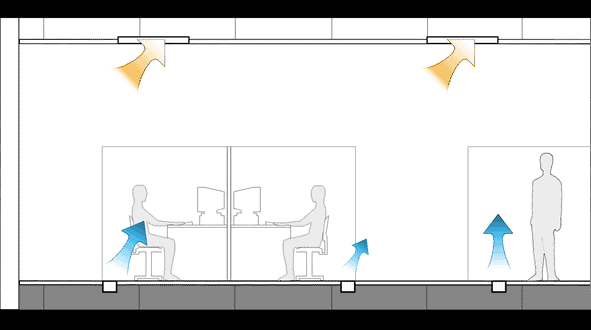|
Ventilation of auditoriums
A common method of supplying air to auditoriums is to supply air
under the seats in the belief that the air will float slowly upwards,
thus achieving a displacement effect. This is not correct however.
The air behaves like water and "flows" downwards where
it collects before it flows slowly upwards towards the rear outlet.
The supply air mechanisms could just as easily be installed at
the front of the auditorium.
Regardless of the location of supply air mechanisms, experience
shows that is difficult to achieve any real displacement effect.
Measurements and computer simulations for a solution as outlined
above indicate a ventilation efficiency of roughly 100%, which
entails complete agitation of the air.
Tests have also been carried out for traditional ventilation
with (vortex) diffusers in the ceiling. This works satisfactorily,
provided the outlet is located towards the rear. Locating the
outlet in other spots may easily result in full short circuiting.

Suggestions for sensible ventilation of auditoriums:
1. Ventilation by diffusion with air supplied from the ceiling/rear
by, for example, vortex diffusers. Outlet at the rear.
2. Diffuse supply of air under or in front of seats. Supply of
air beneath the seats has not other significance except that it
is often practical to use the space below the seats as a supply
chamber.
3. In addition to the above, the rear of the auditorium should
be ventilated separately. This is particularly the case when it
serves as an entrance area so that users are not met by a "wall"
of hot, polluted air.
Pictures from our applicaiton.(Turkish
Parlement Hall )
Design of the supply air systems in ventilation by displacemen
For displacement-type ventilation at premises with normal heat
sources in the form of people, light, etc., experience shows that
the temperature change between floor and ceiling is roughly as
shown in the figure below:
|

